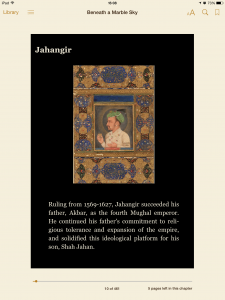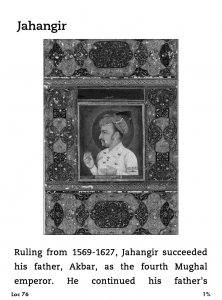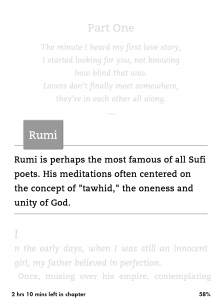 I’ve been skeptical of enhanced ebooks. When I read a book, especially fiction, I want to immerse myself in the book. I don’t want to be distracted by anything else. Non-fiction is different. There I like links, tables, charts, images and other elements (like video) which can enhance the experience.
I’ve been skeptical of enhanced ebooks. When I read a book, especially fiction, I want to immerse myself in the book. I don’t want to be distracted by anything else. Non-fiction is different. There I like links, tables, charts, images and other elements (like video) which can enhance the experience.
I haven’t found many enhanced ebooks that worked for me, but recently I had an opportunity to interview Sherisse Hawkins of Beneath the Ink. I think they are on a good path.
Sherisse comes from a tech and entertainment background which gives her insight into how people want to be entertained–one of her first jobs was working for Disney, and even though she was an engineer, she still went through the entire Disney customer experience training.
She loved the idea of making meaningful connections between authors and readers, connections that go beyond interacting on social media. What if those connections could happen within the book itself?
It’s an intriguing idea, and it’s behind what they are trying to do at Beneath the Ink. We covered them on TeleRead early last year, and it’s obvious things have changed and developed at the company. They sent me a sample copy of a book to experience, and it’s a good one to show what they are trying to accomplish.

The book is [easyazon-link asin=”0929701976″ locale=”us”]Beneath a Marble Sky[/easyazon-link] by John Shors. One of Beneath the Ink’s goals is to have their books accessible on any device, from a first generation Kindle to the latest and greatest tablet. I tested the book on both my Paperwhite and my iPad (using iBooks).
Obviously, you get the richest experience on the iPad. The book came with a welcome message from the author in audio. Because the novel is set in India, the beginning of the book featured a list of historical characters, with pictures and an audio file giving the proper pronunciation of their names. Nice feature. I’m one of those readers who hates not knowing how to pronounce a name.

As you can see from the screen shots, the Kindle version is lacking the color and the pronunciation guide is also missing, but the images display well.
As you read through the book, you’ll see highlighted words. These are “binks,” which can be tapped to bring up additional information, as you can see in the following screen shot.

Think of them as footnotes on steroids. They don’t interrupt the text too much, although I did find it annoying to see them repeated throughout the book. I see the point. Just because I tap a bink once doesn’t mean I might not need a refresher later, but I did catch myself almost compelled to tap them each time, just because they were there.
What this tells me is that I’m not their ideal audience, at least for fiction. As I said earlier, I prefer to immerse myself in a story, and the binks stopped me from doing that. For non-fiction, however, I think the binks could be helpful and would enhance a book.
One of my questions was cost. Do the enhanced ebooks cost extra? While the authors decide what to charge for their books, Sherisse says that so far authors have chosen to not charge extra for the enhancements. I think that’s wise. While arguably the enhancements do add value, how much value will depend on the reader, and some won’t be willing to pay more for them.
I like what they are doing. If enhanced ebooks are going to take off, they need to be accessible in the apps and devices people want to use. By making them accessible on both older eInk devices and newer tablets, Beneath the Ink is meeting readers where they are instead of forcing them into yet another ereading app.




























Thanks for a great article and the link to Beyond the Ink. I got my start in publishing enhancing public domain books for print, so I’m all for anything that will enhance the ebooks I’ve been writing in recent years. Mostly it’s been starting each chapter with a helpful picture (i.e. pictures of cute hospitalized kids for my hospital books), but there needs to be more than that, much more.
Those who want to become real experts in the field, particularly for non-fiction, would do well to study the writings of Edward Tufte, the ultimate guru for that topic. His books on graphic illustration of data are classics. You can start at his website:
http://www.edwardtufte.com/tufte/index
—-
And for the record, in addition to its Scrooge-like cheapness with author royalties, much of my anger at Amazon centers on its twin failures:
1. Refusing to get with the rest of the industry and adopt the industry standard ePub. Having a single standard significantly reduces the cost of creating enhanced ebooks.
2. Refusing to support InDesign’s digital export capabilities. But for Amazon’s intransigence, it’d now be possible to produce a top-quality, enhanced ebook with InDesign and almost effortlessly create similarly enhanced digital versions. You can do that for ePub. You can’t for Amazon’s KF8.
[Steps down from anti-Amazon soap box, picks up said soap box, and walks away, shaking his head silently.]
I, too, have found Beneath the Ink’s approach worthy of note and study. It is an excellent beginning. However, and as you point out, this conversation has many more facets to consider. I’m pleased to see that discussion beginning.
As for obtrusiveness in fiction, this could be dealt with in the same way as getting a definition of a word in iBooks.app adding enhanced elements that are accessed in the same way as definitions, synonyms or Wikipedia entries. On mobile, tap and hold, on desktops, Control-click or Right-click.
Non-fiction may not always be much different. You do have a narrative that wends its way throughout the eTextbook but you also want to provide as many in-depth and optional side trips as the topic demands. Some of these such as images (pictures, charts, graphs, diagrams, etc.), audio and video cannot be hidden. They have to be evident so reader discipline applies more than with a novel and multiple readings are the norm.
“it’d now be possible to produce a top-quality, enhanced ebook with InDesign”
People don’t want your enhanced eBook with InDesign, especially if they are fixed-layout. As a matter of fact, they have been so annoying to customers, providing them with and I quote “an experience so bad I want to be reimbursed” that some distributors are starting to reject them.
How do I use binks on my website?
Nancy asks, “How do I use binks on my website?”
My answer: Pretty much the same way you’d do this in an ePub 3 document, use HTML and javascript.
For example, here’s one that I use on my web site: http://www.theradiantbody.com/js/shadowbox-1.0b/